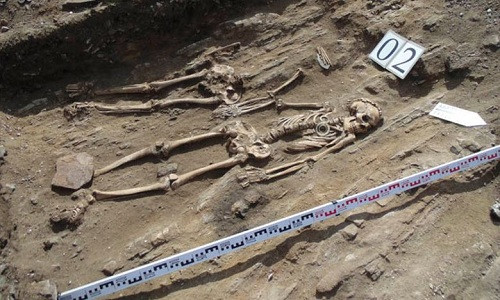The lovers hold each other's hands tightly for 5,000 years in the tomb
A 5,000-year-old grave near Lake Baikal in Siberia attracts many scientists' attention because of the eternal love shown in the clutches of the lovers in the grave.
According to The Siberian Times, the ancient couple is an older man and his wife or concubine. They are buried together to maintain eternal love. Archaeologists believe that lovers live in the Bronze Age.
The skeleton of the man comes with a ring made of rare white jade on the eye sockets. Three other rings were found on this person's chest."It is possible to express the conception of the burial about life in the afterlife," commented archaeologist Dr. Dmitry Kichigin of Irkutsk National University of Technology Research.

The skeleton of the man and woman clasped each other's hands in a 5,000-year-old tomb.(Photo: Dmitry Kichigin).
The skeleton skeleton of the couple was sent to Canada to analyze carbon radioactivity, but the archaeological team excavated the tomb in Russia to conclude two sets of remains dating back 4,500 - 5,000 years. " In the grave, we found the skeleton of men and women lying on their backs, heads facing west, hands clenched , " Kichigin said. The area where the tomb is found is a sacred burial site from the Neolithic period that overlooks Lake Baikal, one of the oldest and deepest lakes in the world.
The skeleton of the man was still intact, but the mouse destroyed the woman's upper body. Near the woman lies a large size knife made of jade, 7 cm wide and 13 cm long. The pendant from red deer teeth and musk deer is found around the skull and legs of the man, most likely to be used to decorate hats and shoes.
"We are very fortunate to find at least one skeleton in perfect condition with decorations. It is interesting to find out the purpose of using a large jade knife near the woman" , Kichigin said.
In addition to the knife, the excavation team also found a number of metal utensils placed in a small leather bag in the middle of the man's kneecap. Archaeologists will analyze the findings this fall.
- How to hold your hand to tell your personality
- Human hands evolve earlier than we think
- Simple movements to remember
- The corpses 'hold hands' together for 1,500 years
- Scary discovery about 1,400-year-old 'tomb of ghosts'
- Female hands contain a secret that only when holding the hand he discovered
- Hold your hands for 30 seconds to know your health status
- Holding hands with your lover, your partner is an effective way to relieve physical pain
- Should hold hands to remember more effectively
- The couple's couple hugged each other tightly for 3,000 years
- The oldest pair of lovers in the world
- The secret of an ancient tomb is 800 years old in China
 Discovered an ancient centipede fossil 99 million years old
Discovered an ancient centipede fossil 99 million years old Discovered bat-like dinosaurs in China
Discovered bat-like dinosaurs in China Discovered a 200-year-old bronze cannon of the coast
Discovered a 200-year-old bronze cannon of the coast Discover 305 million-year-old spider fossils
Discover 305 million-year-old spider fossils